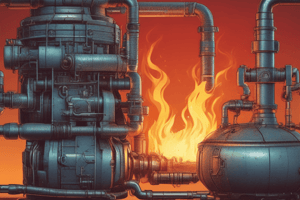Podcast
Questions and Answers
What is the byproduct of complete combustion?
What is the byproduct of complete combustion?
- Carbon Monoxide
- Oxygen and Fuel
- Heat and Light
- Carbon Dioxide and Water (correct)
What is the term for the three essential elements for combustion to occur?
What is the term for the three essential elements for combustion to occur?
- Fuel Chemistry
- Combustion Equation
- Fire Triangle (correct)
- Fire Prevention
What is the typical temperature range of an adiabatic flame?
What is the typical temperature range of an adiabatic flame?
- 500-1000°C
- 1500-2000°C (correct)
- 1000-1500°C
- 2000-2500°C
What type of ignition occurs due to an external energy source?
What type of ignition occurs due to an external energy source?
What is the lowest temperature at which a fuel can ignite?
What is the lowest temperature at which a fuel can ignite?
What is the purpose of fire prevention strategies?
What is the purpose of fire prevention strategies?
What type of fuel is wood an example of?
What type of fuel is wood an example of?
What is the energy released per unit of fuel during combustion?
What is the energy released per unit of fuel during combustion?
What is the purpose of using foam in fire fighting?
What is the purpose of using foam in fire fighting?
What is the term for the equation that represents complete combustion?
What is the term for the equation that represents complete combustion?
Study Notes
Combustion Reactions
- Complete Combustion: A reaction where a fuel reacts with oxygen to produce carbon dioxide and water, releasing heat and light energy.
- Incomplete Combustion: A reaction where a fuel reacts with oxygen to produce carbon monoxide, water, and heat energy, often due to insufficient oxygen.
- Combustion Equation: CxHy + (x + y/4)O2 → xCO2 + (y/2)H2O + heat + light
Fire Safety
- Fire Triangle: Three essential elements for combustion to occur: fuel, oxygen, and heat.
- Fire Prevention: Strategies to prevent fires, including:
- Removing fuel sources
- Reducing oxygen supply
- Minimizing heat sources
- Fire Fighting: Methods to extinguish fires, including:
- Water: cooling and smothering
- Foam: smothering and cooling
- Dry Chemical: smothering and cooling
- Carbon Dioxide: displacing oxygen
Flame Temperature
- Adiabatic Flame Temperature: The maximum temperature reached by a flame, typically around 1500-2000°C.
- Factors Affecting Flame Temperature:
- Fuel type and chemistry
- Oxygen supply
- Pressure
- Moisture content
Ignition Sources
- Piloted Ignition: Ignition due to an external energy source, such as a spark or flame.
- Spontaneous Ignition: Ignition due to internal energy release, such as heat generated by chemical reactions.
- Common Ignition Sources:
- Electrical sparks
- Open flames
- Hot surfaces
- Chemical reactions
Fuel Chemistry
- Fuel Types: Solid, liquid, and gaseous fuels, including:
- Hydrocarbons (e.g., gasoline, propane)
- Carbon-based fuels (e.g., wood, coal)
- Fuel Properties:
- Flash Point: The lowest temperature at which a fuel can ignite.
- Autoignition Temperature: The temperature at which a fuel can spontaneously ignite.
- Heat of Combustion: The energy released per unit of fuel during combustion.
Combustion Reactions
- Complete combustion occurs when a fuel reacts with oxygen to produce carbon dioxide and water, releasing heat and light energy.
- Incomplete combustion occurs when a fuel reacts with oxygen to produce carbon monoxide, water, and heat energy, often due to insufficient oxygen.
- The combustion equation is CxHy + (x + y/4)O2 → xCO2 + (y/2)H2O + heat + light.
Fire Safety
- The fire triangle consists of three essential elements for combustion to occur: fuel, oxygen, and heat.
- Fire prevention strategies include removing fuel sources, reducing oxygen supply, and minimizing heat sources.
- Fire fighting methods include water (cooling and smothering), foam (smothering and cooling), dry chemical (smothering and cooling), and carbon dioxide (displacing oxygen).
Flame Temperature
- Adiabatic flame temperature is the maximum temperature reached by a flame, typically around 1500-2000°C.
- Factors affecting flame temperature include fuel type and chemistry, oxygen supply, pressure, and moisture content.
Ignition Sources
- Piloted ignition occurs due to an external energy source, such as a spark or flame.
- Spontaneous ignition occurs due to internal energy release, such as heat generated by chemical reactions.
- Common ignition sources include electrical sparks, open flames, hot surfaces, and chemical reactions.
Fuel Chemistry
- Fuels can be solid, liquid, or gaseous, including hydrocarbons (e.g., gasoline, propane) and carbon-based fuels (e.g., wood, coal).
- Fuel properties include flash point (the lowest temperature at which a fuel can ignite), autoignition temperature (the temperature at which a fuel can spontaneously ignite), and heat of combustion (the energy released per unit of fuel during combustion).
Studying That Suits You
Use AI to generate personalized quizzes and flashcards to suit your learning preferences.
Description
Understand complete and incomplete combustion reactions, combustion equations, and fire safety principles, including the fire triangle.



